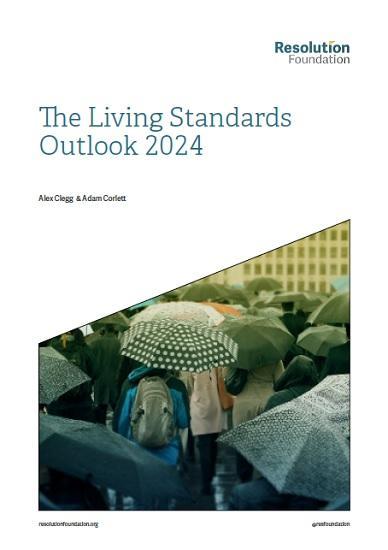The Living Standards Outlook 2024
2nd September 2024

The Resolution Foundation has produced the sixth annual Living Standards Outlook. It provides an assessment of incomes, poverty and inequality as things stand in 2024-25, and projections up to 2029-30 using economic forecasts and policy assumptions inherited by the new Government. It also explores how three scenarios, based on an optimistic outcome for earnings growth and two illustrative social security policy packages, would impact the forecasts.
After what looks set to be the worst Parliament on record for income growth, the new Government came to power promising to kickstart economic growth as the first of its ‘five missions', emphasising that this is the key to unlocking improvements in living standards. This is the right area to focus on as, prior to any new Government policy, the outlook for incomes is weak across the Parliament following a strong 2024-25.
And things are set to be even worse for poorer households, meaning poverty and inequality will likely rise without policy changes.
Key findings
We project strong income growth of 3 per cent in 2024-25, aided by pre-election tax cuts, but weak income growth for the rest of the Parliament based on current economic forecasts and policy assumptions. This is driven by sluggish projections for earnings growth, tax rises, rising housing costs and falling savings interest.
Incomes at the bottom of the distribution are projected to fall in each year of the Parliament, as things stand. Households at the 10th and 20th income percentiles are set to be poorer in 2029-30 than in 2023-24. This would mean essentially no net growth in 10th percentile incomes across the 25 years from 2004-05 to 2029-30.
Under current benefit policy assumptions, relative poverty is set to rise, especially for children. The number of children living in relative poverty is projected to rise by 1.5 million to reach 4.6 million by the end of the decade. Absolute poverty is set to stagnate at 18 per cent of the total population.
Faster earnings growth is much-needed, and would inevitably boost household incomes and slightly reduce absolute poverty. But in isolation this would only speed up the projected rise in relative poverty and inequality.
We therefore show the impacts of two illustrative benefit reform packages: First, ending the handful of policies that break the link between need and entitlement in the social security system: the two-child limit, the benefit cap, and the freeze to the Local Housing Allowance. And second, linking annual working-age benefit uprating to growth in earnings rather than prices.
The first of these packages would lift 1 million people (including 600,000 children) out of relative poverty immediately, while the second would stabilise the relative poverty rate, rather than allowing it to rise again throughout the rest of the Parliament.
Read the full report HERE
Pdf 38 Pages
